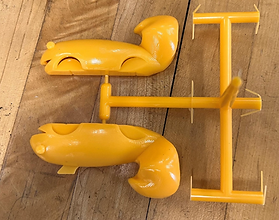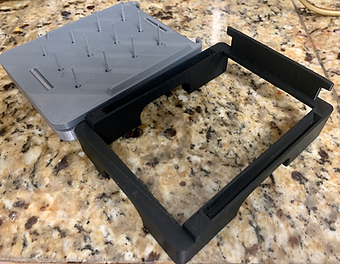My Portfolio
Welcome to my portfolio. Here you’ll find a selection of my work. Explore my projects to learn more about what I do.
TE Connectivity Manufacturing Expo
I collaborated with 2 other undergraduates to work with middle schoolers at Broughal Middle School to design and race matchbox cars down an undulating track.

Race track at Broughal Middle School


Original drawing and designer approved 3D model
We interpreted and upscaled the drawings of a "Catshark" given to us by the middle schoolers to create a 3D model of the car in SolidWorks. We also 3D modeled the mold plates
I used NX CAM to design and then simulate the tool path that would be used to mill out and machine the aluminum injection mold plates. I also used Moldflow to simulate the injection molding process to ensure the pressures and temperatures of the plastic would yield the expected results.

Milled aluminum mold plates
We injection molded several copies of the part to fine-tune the proper plastic temperature and pressure.

Fully assembled racing cars
The finished bodies were painted and suited with axles and wheels from other matchbox cars. Slugs and scrap metal were used to properly distribute the weight of the racing cars.


Injection molded shells of the matchbox car

Team Catshark car display

Race testing the cars
Tools for Cell Culture
I worked in a group with 3 other undergrads to create a device that provides a cost-effective, quick, and reproducible method for performing cell scratch assays.


Exploded View of my final design concept
Section View of my final design concept
What is a Cell Scratch Assay?
Cell scratch assays are a technique used in research to understand cell migration and response. It is done by growing a monolayer of cultured cells in a well plate and then creating a scratch in each well with a fine tip or sharp object. Images are then taken in regular intervals after the scratch for analysis of cell migration and response. This process is essential for researchers studying cancer propagation, tissue formation, wound healing, immune response, and embryological development.

Manual scratch assay being performed
Manual scratch assays while cheap are imprecise and can be time-consuming and automated options available are too expensive for academic research labs. So our group was tasked to create a device that would find a happy medium between manual scratch assays and automated scratch assays.

Early Prototypes and Prints
My groupmates and I brainstormed various design concepts to choose the best designs to further develop and prototype. Then using SolidWorks, I 3D modeled and printed various prototype iterations tweaking tolerances and problematic aspects with each iteration.





SolidWorks models of prototypes
One of our groups alternative prototype designs



Our group then used our 3D printed designs to test out certain facets of the design such as scratch uniformity, material sterilization, and overall product feasibility.

Scratch results of one of our prototypes. In a majority of the wells the scratches are not clean leading us to reevaluate material and production methods.
Testing of PLA properties after prolonged UV and ethanol exposure
My final design prototype of my hook and rail design concept
We were not able to finish the project given we were provided a little less than a year, but the project provided insight into the back and forth collaboration process in creating a product for a sponsor.

User Guide for my final prototype
Device for Brain Injury Studies
Over the past 2 years, I have been gaining professional experience in my Lab Internship studying biomarkers for traumatic brain injury. I was brought in to optimize a momentum exchange device used to deliver precise head impacts on rats to better facilitate lab research.

3D Rendering of Momentum Exchange Device
The momentum exchange device works by putting the rat in a sled along a track and striking it with a pneumatic piston inducing mild head injury.
When I was initially brought in it was to analyze the device to improve its consistency. The momentum exchange device force output would often not match the desired input resulting inaccurate lab results.
To accomplish this the researchers initially wanted to attach accelerometers to the rats to receive better force output data. So I created helmet models for the rats to house the accelerometers and prevent variability in strike location.


3D models of helmets for the rats
After this efforts were redirected to the momentum exchange device itself. To prevent the strikes from having more force than intended, I lowered the pressure allowed to build up in the pneumatic cylinder.

Picture of the momentum exchange device
I also reviewed the prior documentation of the device and discovered that while being manufactured there were issues with concentricity. To account for this I decided to better lubricate the device and properly orient the piston so its angular alignment matches with the chamber.
With these changes along with the recalibrating the pneumatic mechanism, the force outputs of the device had less variability and enabled more reliable research results.

Rudimentary angular alignment of the piston shown via the blue tape



